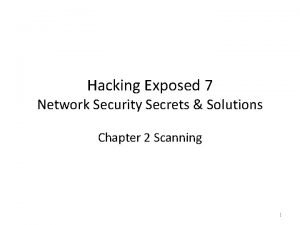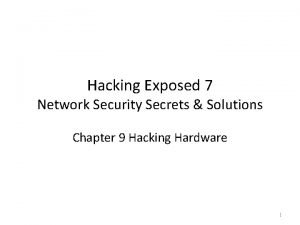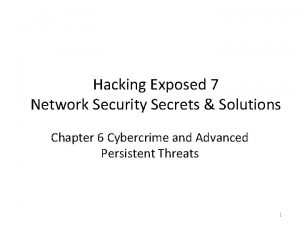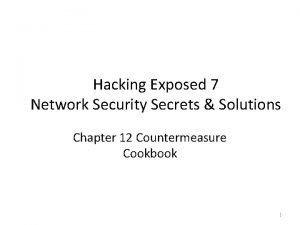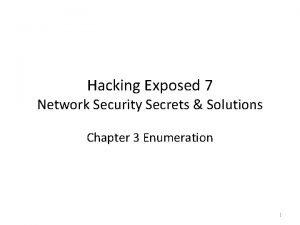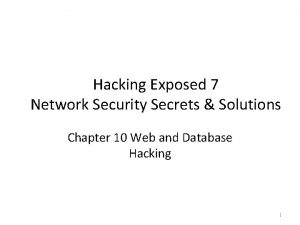Hacking Exposed 7 Network Security Secrets Solutions Chapter









- Slides: 9

Hacking Exposed 7 Network Security Secrets & Solutions Chapter 2 Scanning 1

Scanning • Determining if the system is alive • Determining which services are running or listening • Detecting the operating system • Processing and storing scan data 2

Determining If the System is Alive • Network ping sweeps – ARP host discovery: on the same subnet • Arp-scan: run as root by sudo to list IP-MAC • Nmap (Network Mapper): host and service discovery with various options (host only: -PR –sn) • Cain (Windows-only): beyond host and service discovery – ICMP host discovery: remote host/router • ICMP ECHO REQUEST, ICMP ECHO REPLY, ICMP TIMESTAMP, ICMP ADDRESS MASK, etc. • Ping: OS utilities for ECHO REQUEST/REPLY • Nmap: ICMP ping/address mask/timestamp, ARP ping, TCP ping • Hping 3 and nping: any combinations of flags on any combinations of packet types, spoofing MAC/IP • Superscan: multiple ICMP in parallel – TCP/UDP host discovery: when internal and/or external ICMP is not permitted • Servers: TCP/UDP service ports • Desktops: local firewall to ban inbound connections, but accessible through remote desktop, file sharing, and disabled local firewall • Nmap/Superscan/Nping: all ports (slow and noisy) or specific ports 3

Ping Sweeps Countermeasures • Detection – IDS: snort – Commercial firewall: network or desktop • Detect ICMP, TCP, UDP ping sweeps – A pattern of ICMP/TCP/UDP packets from a particular system or network – Host based tools: Scanlogd, courtney, ippl, protolog – Not just tools, eyeballs count. • Prevention – ACL in firewall: types of ICMP traffic into your networks or systems – Allow only ECHO, HOST UNREACHABLE, TIME EXCEEDED into specific hosts in DMZ; allow only ISP’s specific IP addresses • Loki 2: hackers use it to backdoor the OS and tunnel data in ICMP ECHO – Pingd: move ICMP from kernel to user space 4

Determining Which Services Are Running or Listening • Port scanning – – Identifying TCP/UDP services running on the target Identifying type of OS of the target Identifying applications or versions of a service Scan types • TCP connect scan (3 -way handshake), TCP SYN scan (half-open scan, SYN then SYN/ACK or RST/ACK), TCP FIN scan (RST if closed port), TCP Xmas Tree scan (FIN/URG/PUSH), TCP null scan, TCP ACK scan, TCP Windows scan, TCP RPC scan, UDP scan (ICMP port unreachable if closed port) – Nmap • Port scanning after host discovery • Options: -o. N (out to a human-readable file), -f (fragment packets to pass firewall/IDS), -D (intermix decoy scans and real scans) – Super. Scan (Windows-based with GUI), Scan. Line (Windowsbased with command-line), netcat (Windows/Linux, minimize your footprint on a compromised system, Swiss Army knife of security; netcat for Nmap = ncat) 5

Port Scanning Countermeasures • Detection – Snort: packet fragmentation handled after 1. x – Scanlogd: detect and log – Firewalls: • e. g. , detect SYN scans but ignore FIN scans • threshold logging – group alerts to one email – Attacker: listen for particular ports and alert • Prevention – Disabling all unnecessary services/ports – /etc/inetd. conf in UNIX 6

Detecting The Operating System Active Operating System Detection • Useful info for vulnerability mapping – Banner grabbing: some applications tell it all – Scanning available ports: some services are OS specific! – Stack fingerprinting: TCP/IP stack implementation • Making guess from available ports – Windows: ports 135, 139, 445 (139 only for Windows 95/98); 3389 for RDP (Remote Desktop Protocol) – UNIX: TCP 22 (SSH), TCP 111 (portmapper), TCP 512 -514 (Berkeley R services), TCP 2049 (NFS, Network File System), 3277 x (RPC, Remote Procedure Call in Solaris) • Active stack fingerprinting – Vendors interpret RFCs differently when writing TCP/IP stack – Nmap –O: signature listing at Nmap-os-fingerprints • FIN probe (Windows 7/200 x/Vista respond with FIN/ACK), Bogus flag probe, Initial Sequence Number sampling, “Don’t fragment bit” monitoring, TCP initial window size, ACK value (+0 or +1), ICMP message quenching, ICMP message quoting, ICMP message echoing integrity, TOS, fragmentation handling, TCP options • Countermeasures – Detection: same as port scanning detection tools – Prevention: secure proxy or firewall 7

Detecting The Operating System Passive Operating System Detection • To be stealthy to IDS: passive • Passive stack fingerprinting – At a central location or a port with packet capture (by port mirroring) – Siphon: a passive port-mapping, OS identification, and network topology tool • Passive signatures in osprints. conf – TCP/IS session: TTL, window size, DF (Don’t Fragment), etc. – Tend to fail if: (1) applications build their own packets, (2) not able to capture packets, (3) a remote host changes the connection attributes (active detection also fails on this) • Countermeasures – Same as OS detection countermeasures 8

Processing and Storing Scan Data • Efficiency in managing scan data speed to compromise a large number of systems • Metasploit – A vast platform of tools, payload, and exploits – Postgre. SQL for database – db_connect: tells metasploit how to connect to database and which database to use – db_nmap (root required): run Nmap scans • Metasploit could scan but slower than Nmap – db_import: import Nmap results into database • hosts: show hosts and their OS • services: show all available ports and services • Filtering (-s) to see, e. g. , all hosts with SSH or running Windows 2008 9
 Hacking exposed 9
Hacking exposed 9 Hacking exposed 9
Hacking exposed 9 Aldy bug
Aldy bug Hands on ethical hacking and network defense
Hands on ethical hacking and network defense Provate security
Provate security Osi model security architecture
Osi model security architecture Security guide to network security fundamentals
Security guide to network security fundamentals Wireless security in cryptography
Wireless security in cryptography Electronic mail security in network security
Electronic mail security in network security Security guide to network security fundamentals
Security guide to network security fundamentals
